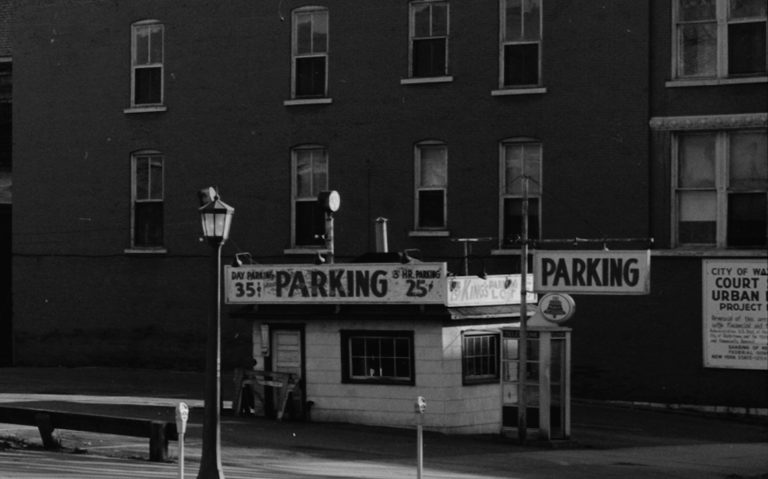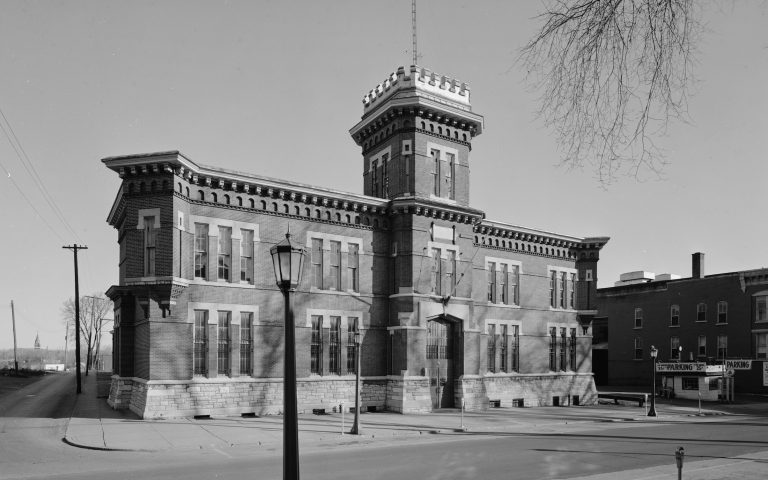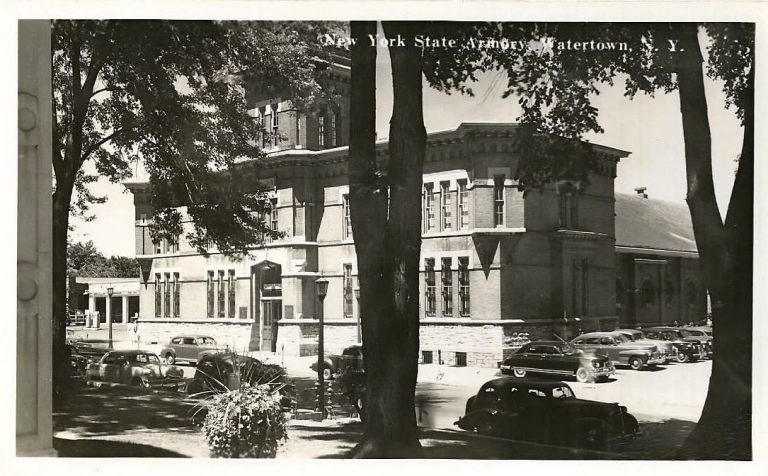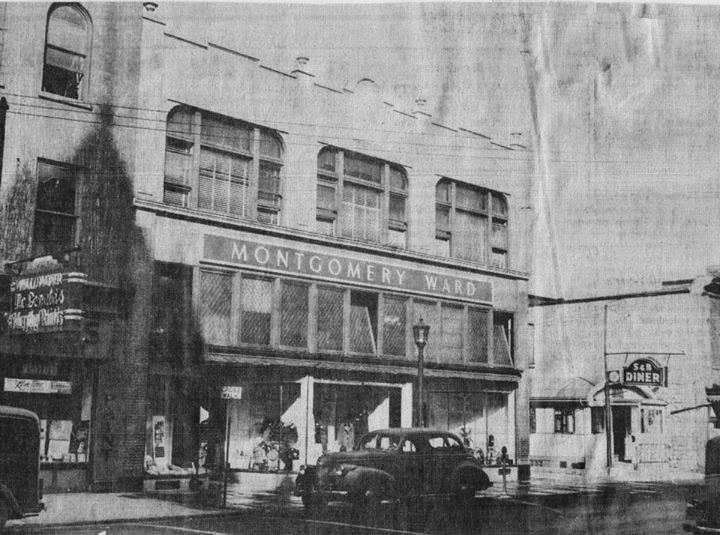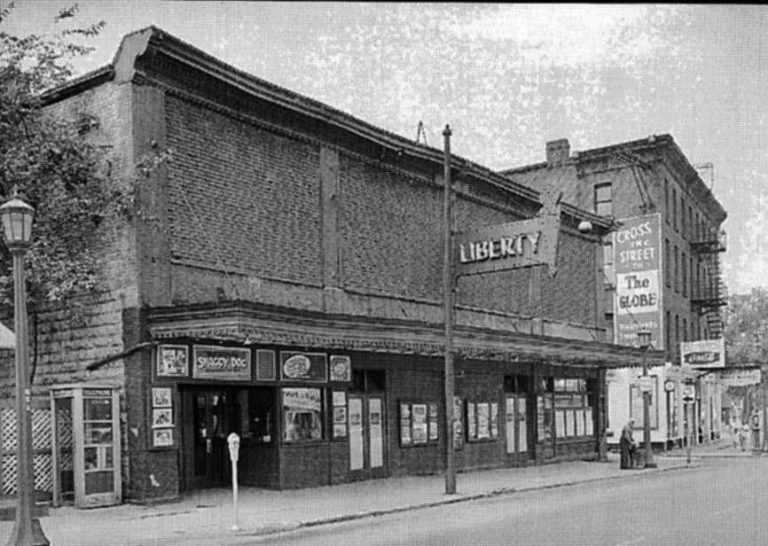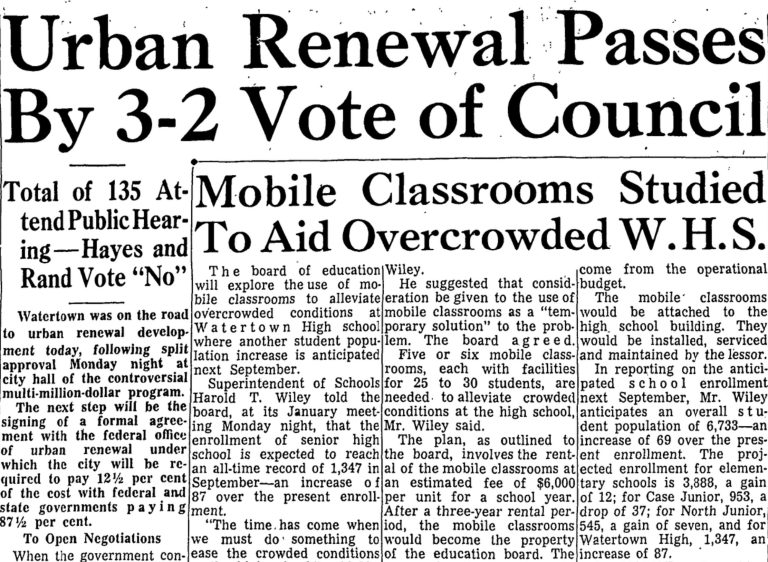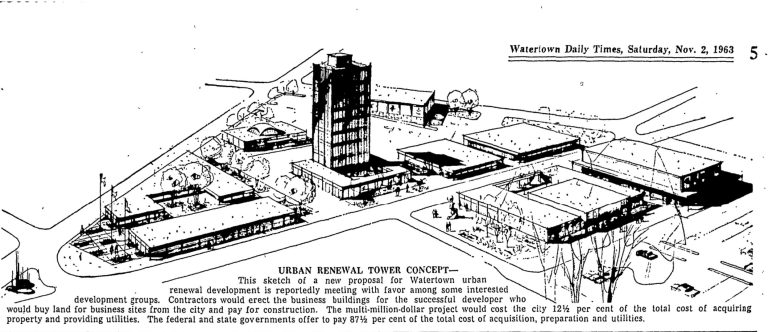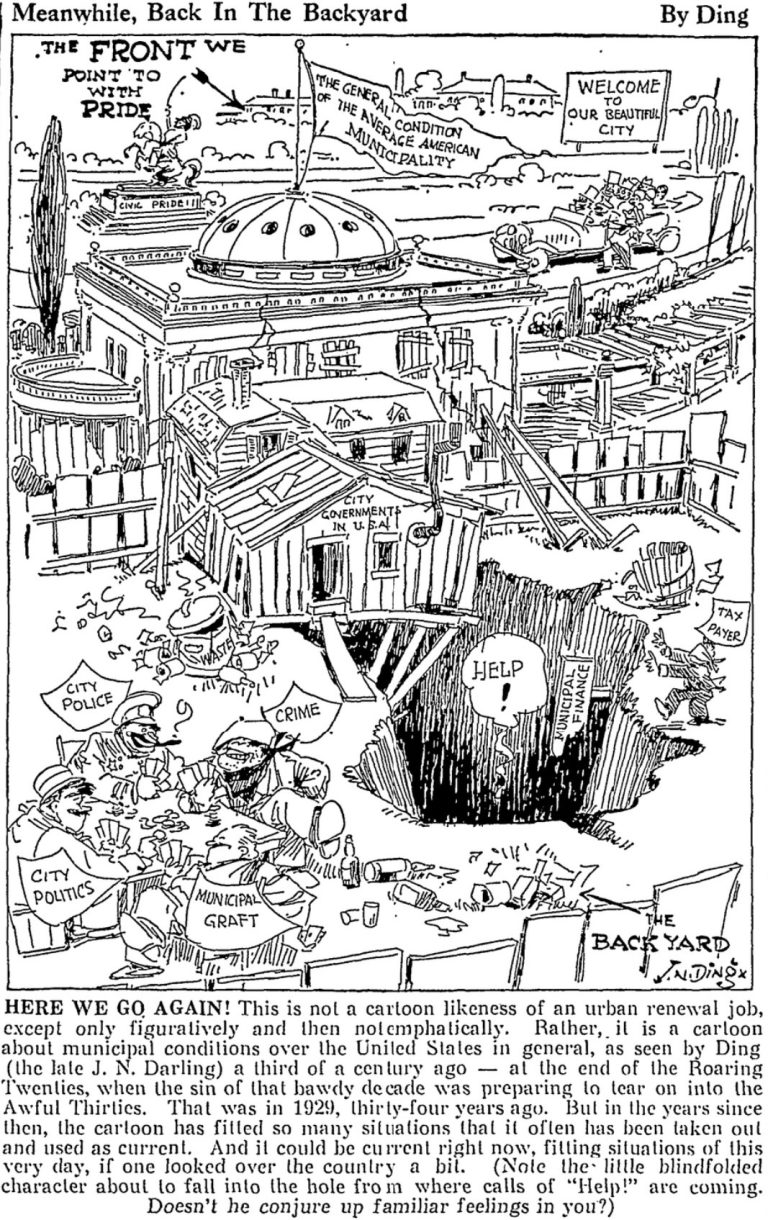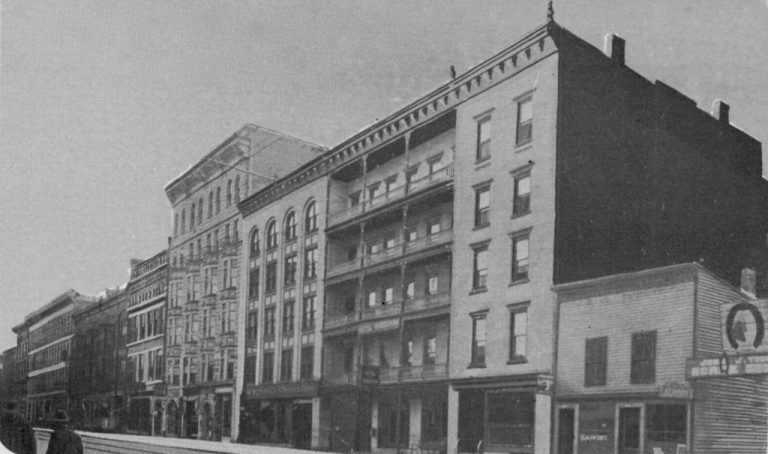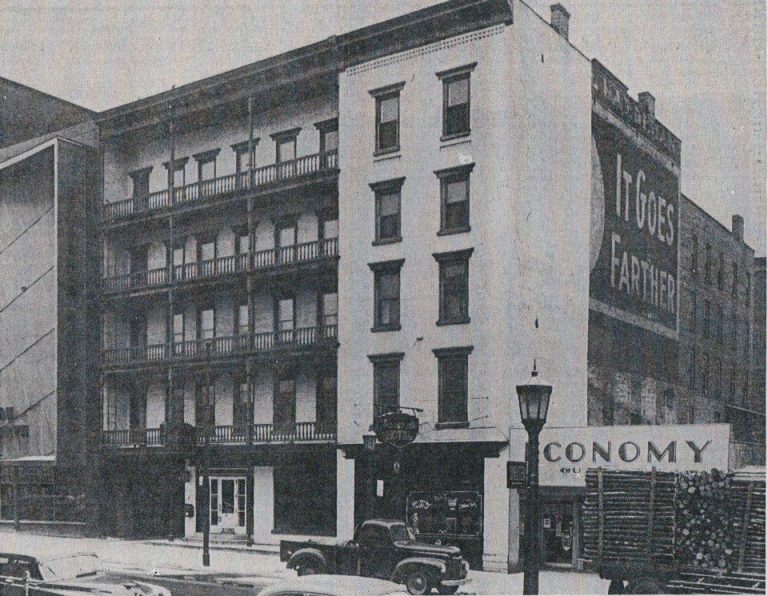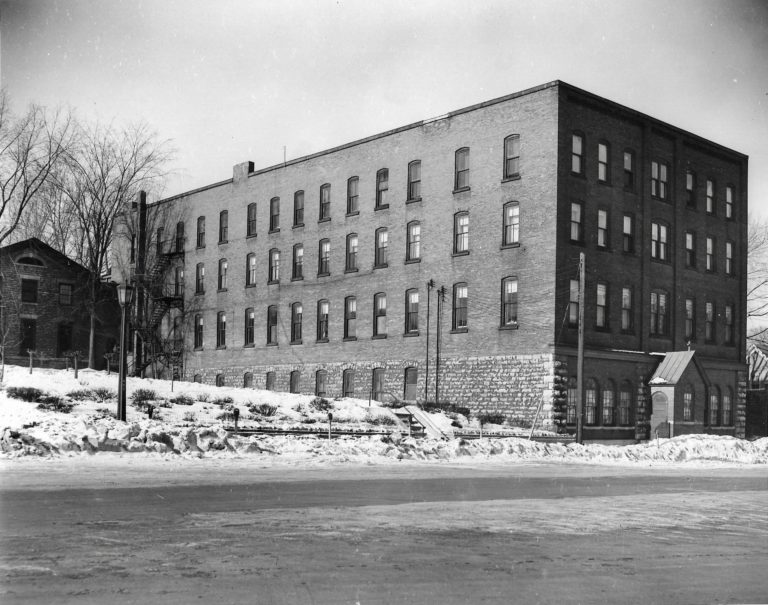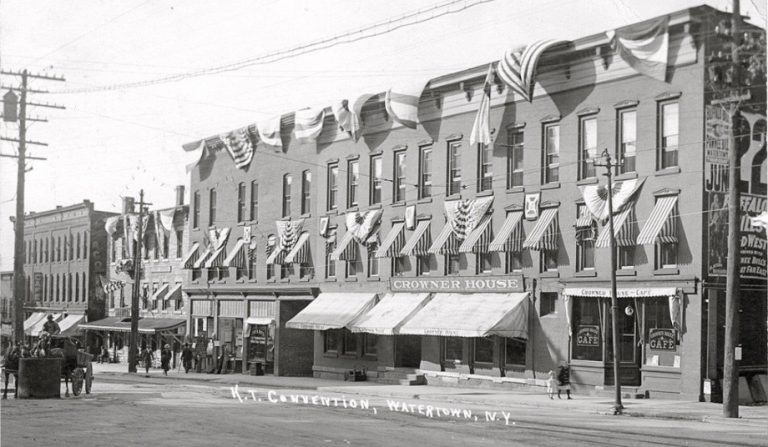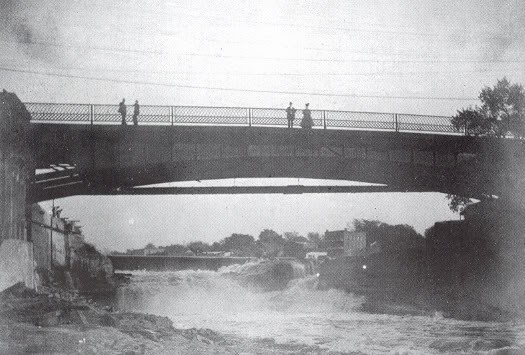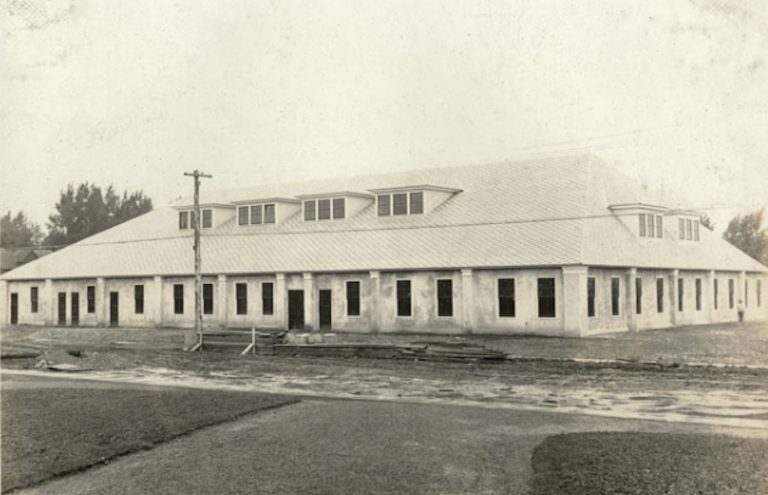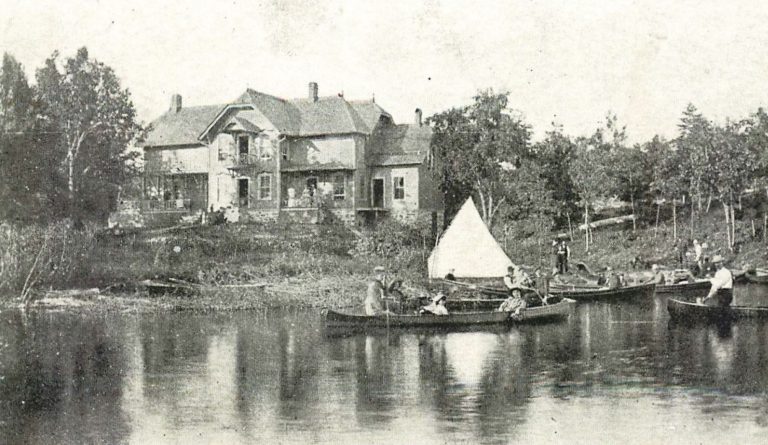The State Armory Takes Center Stage of Watertown Urban Renewal Delays
The Watertown Urban Renewal program entered 1963 with a televised public debate on WCNY-TV’s “Scope” program, which was extended to an hour-long format to give both proponents and those against the project enough time to present their arguments. If you need to catch up on the program’s history, you can find Part I here, and Part II here. The debate was held before the federal-mandated second public hearing conducted by the city council at city hall, which was to be followed by a public forum, again hosted by WCNY-TV, before the council voted.

Before the debate, many questions were posed and answered in the Watertown Daily Times. One particular question asked, “why should it (urban renewal) interest city property owners?
The answer, as printed in The Times, read–
The public demand for more and improved services requires the collection of more money through taxation. The tax burden is shared by all property owners. Commercial and industrial areas provide the earning power of a community and should shoulder considerable of that burden. The share of the area referred to has diminished from approximately 24 percent to 14 percent in the last ten years. This is deemed to be economically unsound unless a measure of correction is found it may be disastrous.
It’s interesting to note the justification, as presented in the press by various parties, continually changes. Presented here, the justification is urban renewal will lower citizens’ tax burdens. Incidentally, after the vote was held on January 8th, a citizen wrote to The Times stating they had purchased their home in 1920 and taxes had risen about 400% since then.
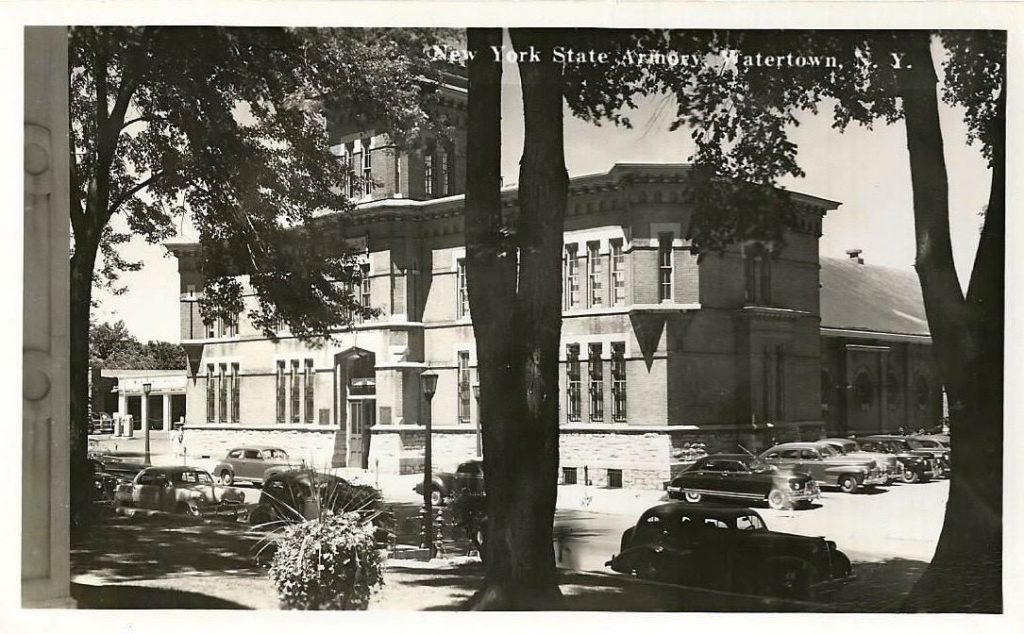
The debate on WCNY-TV focused on Mayor William G. Lachenauer and Attorney Richard F. Schwerzmann, who had opposing views of the program’s validity and costs.
Attorney Schwerzmann’s chief arguments against urban renewal, as printed in The Times, included–
Urban renewal would result in increased taxes rather than decrease because the assessment rates presented by the urban renewal planners were not accurate and the overall project cost would undoubtedly run considerably higher than the proponents would have people believe.
No real planning is evidenced in the urban renewal program. There are too many unanswered questions regarding project costs and the availability of developers.
The cost to the city of building the parking lot and cost of relocating the state armory had not been included in the overall project cost estimate. This would result in the $150,000 to more than $1,000,000 increase in the overall cost. Failure to include these two factors also will raise the city’s share over the $443,991 estimate and increase the taxpayer’s share.
There will be 60 businesses dispossessed by urban renewal and there are only 15 to 20 business places in the city available for relocation. Most of these businesses will not be able to afford to relocate in the Court-Arsenal Streets section once urban renewal has been carried out.
Most of the redevelopers are likely to be national rather than local because most local business groups cannot meet bank standards as developers. Inclusion of a large number of national chain stores will restrict the availability of the urban renewal area to local businesses.
An organization of local businessmen affected by urban renewal banded together might just effectively rejuvenate the section through reinvestment in the Court-Arsenal Streets area. This might be as effective a solution as urban renewal.
Local urban renewal planners have conducted no survey of the local businesses affected by renewal to see which can or can not afford to relocate.
The assessment figure presented for the section after urban renewal development is grossly exaggerated.
Urban renewal could “knock out the guts of the downtown economy,” and put little back into it.
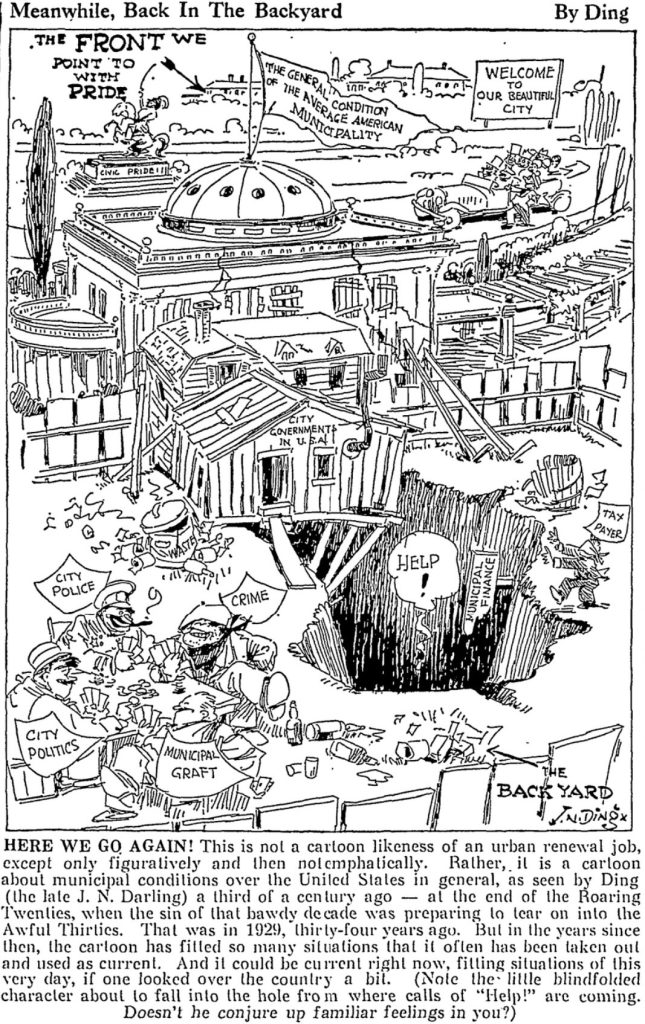
Mayor Lachenauer’s principal arguments included–
Urban renewal will replace the decadence of the principal section of the central business district with a progressive business environment that will enable the city to compete successfully.
Most buildings in the section are more than 100 0years old and little has been done to change their physical look in this period of time.
Urban renewal will result in a decrease of the assessment rate; a drop in taxes rather than an increase.
The city’s share of $443,991 is minimal compared with the benefits of urban renewal will bring to the city.
Local developers have an interest in handling the development phase of the project and there are five to six large national developers interested as well.
There seems to be no alternative to urban renewal which is feasible.
Detailed planning has gone into urban renewal on the local level and the plan is geared toward local needs.
Afterward, the public forum brought out comments for and against urban renewal. George A. Bonadio, a Public Square merchant, cautioned the project as another Factory Square, noting it, too, was once a leading business district but little more than a junkyard at present.
Arnold J. Shapiro, chairman of the Watertown urban renewal council, called the project “practical” and a “first-class answer” to the deterioration and blight that now occupied the downtown district.
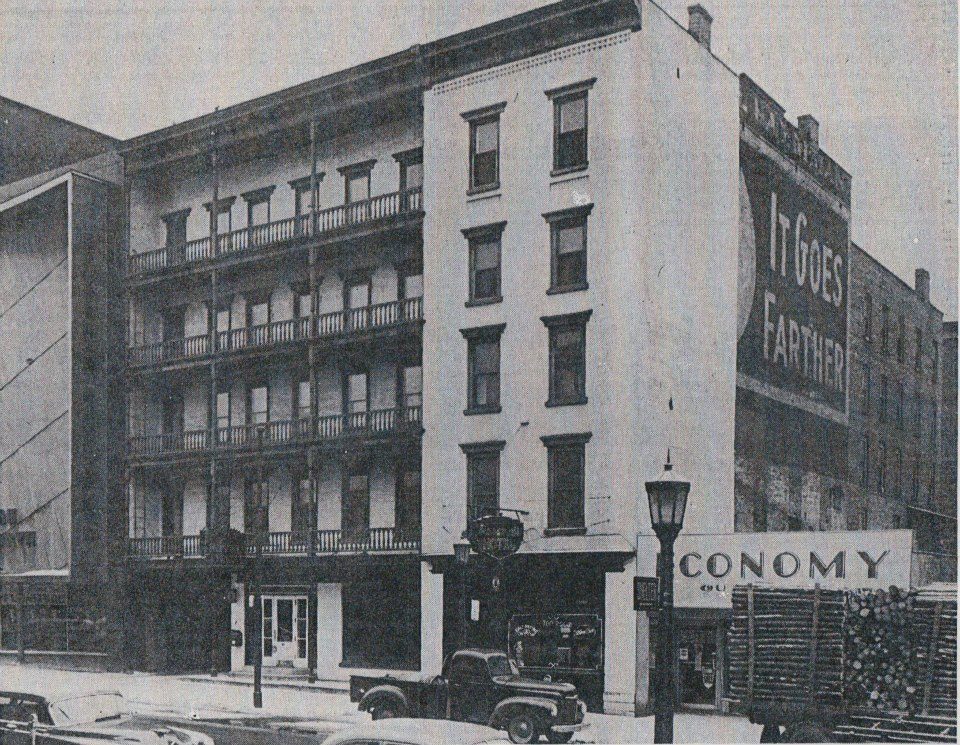
Ira O. Klein, another Public Square merchant on Court Street, believed, in the long run, urban renewal would benefit the city at all and ultimately be a detriment. He noted that, under the current plan, 63 merchants would be forced out of business.
In answering a question, Attorney Schwerzmann summed up the opponent’s feelings about urban renewal when he asked, “Why jump into water to find out if we can swim?” It was perhaps the second-best quote during this two-year period, the other coming up later.
The Watertown Daily Times followed the debate and forum with an editorial, noting, surprisingly–
It is difficult to understand why the opposition failed to voice any protests, feeble or otherwise, during the time that the city council for a year or more made plans to get the federal grant to bring about the revitalization of the Court-Arsenal Streets section. The council proceeded slowly and cautiously and there was little indication that any pronounced strength against the project would develop. Then a few months ago opponents began to marshal their forces.
The urban renewal project, some months ago rarely discussed, now is the topic of conversation throughout the city.
Whatever the result of the council vote, the public cannot say that it was not fully informed as to every minute detail involved in the project.
While there are some points to be made here, what is surprising is the editorial overlooks its own newspaper’s previous comments: “Mr. Forbes pointed out that for necessary reasons, much of the information concerning the project is presently classified, and cannot be divulged to the citizens’ committee until contracts are completed.” How can the public be engaged when they’re unaware of what’s happening behind closed doors?
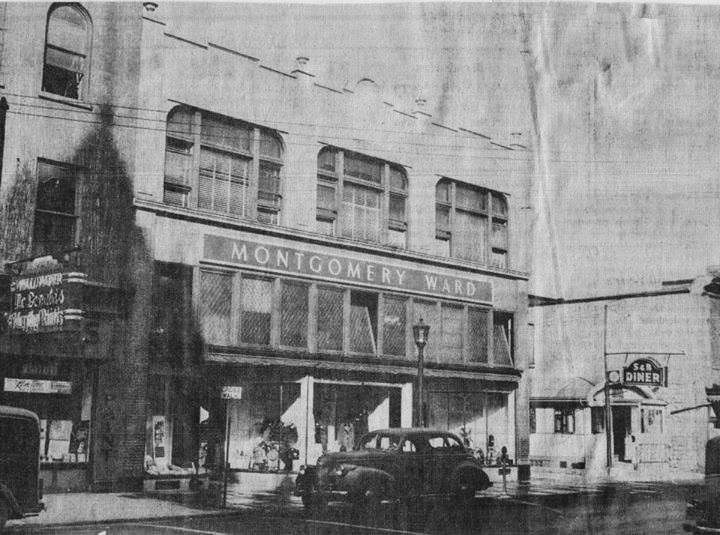
Schenectady: A Cautionary Tale
In the January 5th, 1963 edition of the Watertown Daily Times, an article titled “Schenectady Failed To Lay Foundation For Urban Renewal” outlined a very similar scenario to Watertown’s. Six years prior, Schenectady’s city council was looking to implement urban renewal there but put the cart before the horse, not having any sense of what would go into the areas that were being razed. As a result, no developer expressed any interest six years later, and the empty spaces were used for parking.
As stated in The Times–
“In other words Schenectady’s officials put the cart before the horse. Before going ahead and buying the land from the property owners and razing the several blocks and residences they first failed to task for bids from developers and sign them to contracts.
The councilmen had the mistaken opinion that all that had to be done was to take possession of the land, clear it of the structures and then developers would be clamoring for the construction privilege. But the error of judgment becomes more clear month after month when the vacant land continues to be barren of buildings and there is little prospect of any development for some time.”
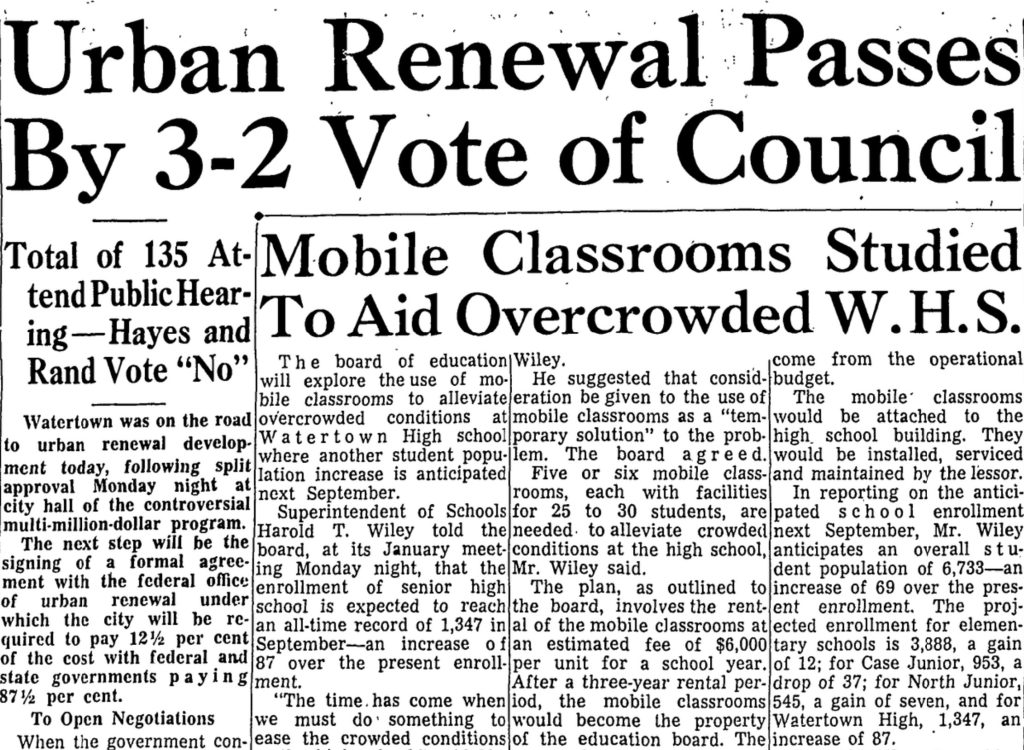
The Vote Is In: 3-2 In Favor of Urban Renewal
When Watertown’s city council voted on the issue on January 8th, the simple majority needed to win, 3-2, with Councilmen Hayes and Rand voting against the project, Hayes having gone against his previous votes for it. The next step entailed signing the formal agreement with the federal office of urban renewal, requiring the city to pay 12.5 percent of the cost, with federal and state funds paying 87.5 percent.
A total of 135 people attended what was described as a “comparatively mild” public hearing, the overflow listening via loudspeakers in the hallways.
The mayor said urban renewal is needed to push Watertown forward economically. He cited the fact that, generally, retail merchants have failed to keep pace with changing times. He pointed out that local industries, utilities, professionals, and businessmen in other fields have recently spent millions on improving their competitive position. In contrast, retail merchants had not, essentially saying, “it’s their own fault.”
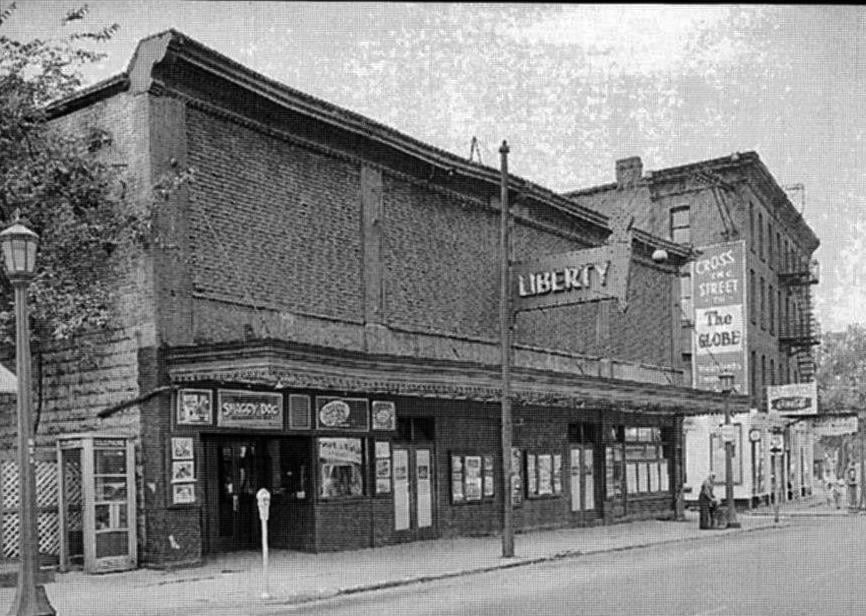
With the cart officially before the horse, the city council could now have serious discussions with urban renewal developers. The council also publicly pledged that no buildings would be razed until construction contracts were signed.
The land was then to be disposed of either by an open bidding process to the highest qualified bidder or the city council had the ability to negotiate with developers. Construction projects were expected to be completed in 1966 under the program.
As it turned out, Attorney Schwerzmann was correct about the armory. On May 10th, City Manager Forbes issued a statement at city hall, reading, in part—
“Although during the planning and survey stage of the Court Street urban renewal project, which is the present status of the project, the city can not acquire property under the project costs. The city has carried on preliminary negotiations with the state national guard for acquisition of its site for the project. These negotiations were carried on during the planning and survey stage at the urging of the federal urban renewal regional office and of the state division of housing and community improvement because of the complicated nature of acquisition of this state-owned site and because of the important location in the project area.
These negotiations have been going on for approximately 18 months. Every attempt has been made to work out a solution for acquisition on a reasonable and fair basis. And offer has been made in the preliminary negotiations which was considered reasonable and fair value for the site. The amount was $225,000 based upon appraisals. This offer has been before the state national guard for five months.
Thursday this office was advised by telephone that the offer could not be accepted. The state national guard has asked for and apparently still wants $450,000 for the site. This office does not consider this price set by the state as reasonable or fair.
Negotiations will continue to work out a solution.”
On May 23rd, the federal government approved a $3,283,800 urban renewal grant for Watertown, which would allow the city to start the activity on the 18-acre Court Street project.
The cost represented 3/4 of the project’s estimated cost, including assistance for 55 families requiring relocation as a result. 179 dwelling units, considered “sub-standard buildings and obsolete, deteriorating stores,” which the administration described as “indiscriminately mixed with rundown apartment buildings and rooming houses.”
Meanwhile, Watertown’s $1,500,000 city hall project clung to life despite not having enough funds, though federal assistance amounting to $600,000 was expected to help push the stalled project through Washington, D.C. The projected site for the new city hall was where it currently is, on the corner of Washington and Sterling Street. The final grant tally, $642,500, was accepted unanimously near the end of July.
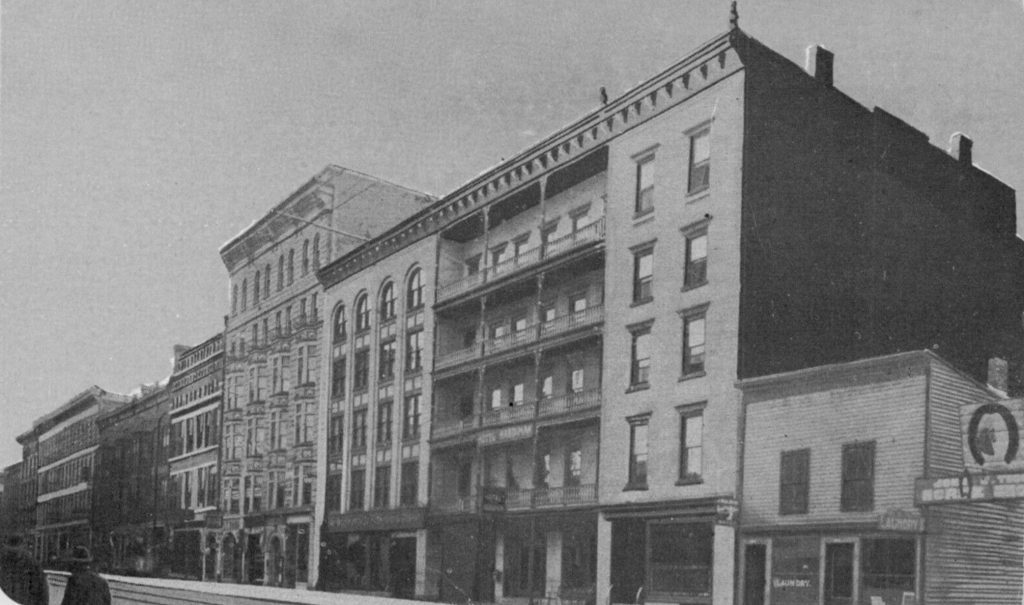
The Washington Street site would later be discussed by Mayor Lacheneauer, noting 19 original sites were proposed, most being in the urban renewal area. The chosen site was “a good buffer between existing commercial and limited business sections of lower Washington Street,” according to a Daily Times article dated July 23.
Upon receiving the $3,283,800 grant from the federal government, the city’s share of the bill rose to $534,358. This did not include any new developments of the state armory other than it was believed they might not need to build a new facility and instead use the Leso-Leano army reserve center on South Massey Street.
The state armory had, in essence, become a thorn in the side of urban renewal plans. Still, a tentative arrangement with the state had the national guard accepting the offer, dependent on their ability to acquire a three-year lease at the South Massey Street property.
The city was eventually told it would have to bid on the building in a public auction, but before it was held, the state said it would accept a price of $196,000 several weeks in advance.
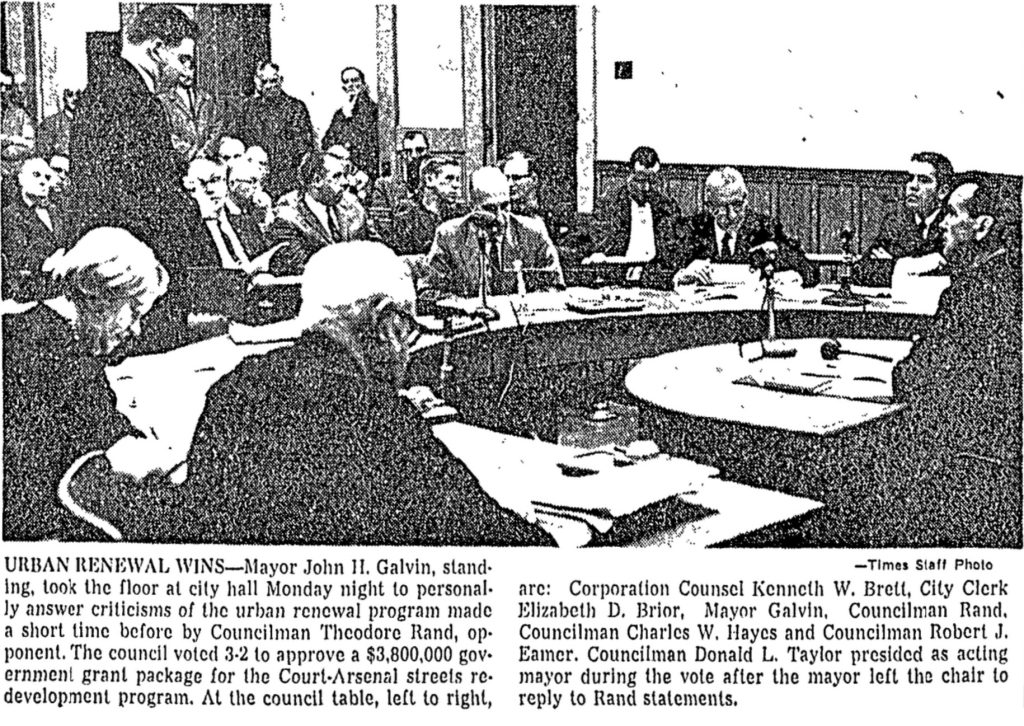
On November 6, Mayor Lachenauer lost his re-election bid to Attorney John H. Galvin by nearly 1,600 votes. This led to the city council’s vote on accepting the federal government’s now $3.9 Million grant to be deferred, according to the Mayor, due to the council’s “lame duck” status. The vote was also to include the offer for the armory.
Before the vote, scheduled for February, the city council decided to take a look at three urban renewal efforts, one in Torrington, Conn., and the other two in Binghamton and Schenectady, NY, which still hadn’t any luck developing its now vacant property for use other than for parking lots. Councilman Hayes decided to skip the trip at the last moment, stating he believed it would pass, but he still planned to vote against it, regardless.
On February 17th, the editorial page of the Watertown Daily Times stated that with its resolution it faced on urban renewal later that night, the city council will have taken action for at least the 25th time dating back to 1958, regarding the project. The letter demonstrates some of the issues big-budget projects face with the development and planning phases potentially spanning over council members and mayoral terms where newly elected individuals may change the trajectory of a plan in motion or wield the power to stop it in its tracks.
The vote was held that night and approved 3-2 as predicted, however, the city would not be able to get any federal funding until the council moved to acquire the state armory. The vote for that was expected to be the same 3-2 split when held within the next couple of weeks.
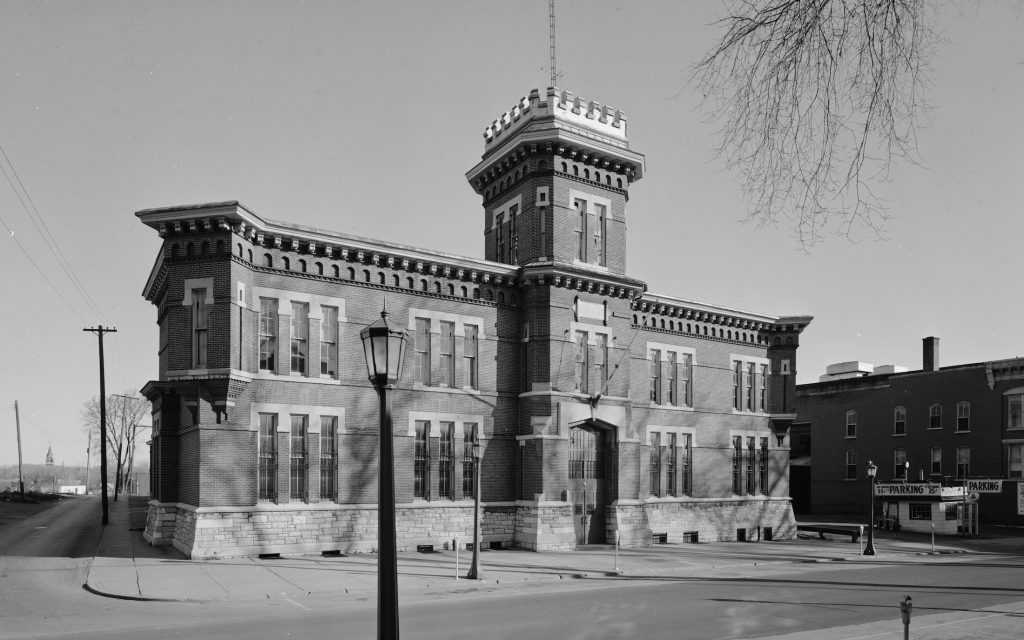
The quote that may have defined the entire opposition movement and was very apropos, even more so in hindsight, as printed in The Times, belonged to Councilman Rand, who stated he was sorry to be a member of the council “where the operation is successful, but the patient dies.” He predicted, in effect, an economic disaster for the project.
By the end of the month, the city council had to authorize the borrowing of $350,000 to pay for immediate financial issues caused by approving the federal grant, chiefly the $197,000 expenditure of purchasing the state armory.
In March, the city’s urban renewal contract was signed by the New York State assistant director of the federal urban renewal department, James P. Sweeney. According to Mayor John H. Galvin, the project’s total costs were (now) estimated to cost between $8,000,000 and $10,000,000.
The city finally purchased the state armory building in May, six months after its originally scheduled auction. The purchase was a major hurdle cleared from the urban renewal project moving forward. The following month, the city council voted the Watertown Housing Authority as its official agent for housing displaced residents of the Court-Arsenal Street project area. The budget set aside for the displaced residents was not to exceed $7,500.
A state housing official would sound the alarm on cities “encouraging preparation of unrealistic plans,” citing in a check by the state agency of 29 communities the previous August found 22 plans, including Watertown’s, were rejected or returned for revision. Per The Times—
Mr. Albert A. Walsh charged that the cities failed to determine the number, income, family size and other vital information concerning tenants who would have to be moved from renewal sites.
“Perhaps the most important defect in evaluating the housing needs of site occupants is the widespread tendency to minimize or gloss over the number of families and individuals that will require low rent public housing, or other forms of public assistance.”
With an estimated Nov. 1, 1965 completion date earlier forecasted out of sight now, it was hoped that residents in the area would begin moving out by spring of 1965 and the urban renewal project completed by early 1967.
F. W. Woolworth, the same month, expressed interest in creating a model store in the new multi-million dollar urban renewal program. The Times reported, “it is reliably reported that Woolworth officials seek ‘a better corporate image’ in its Watertown facility at which annual meetings of the company are held.”
In early August, the city found progress delayed yet again, this time for approval of Watertown’s final re-use appraisal, which had been completed in May and sent for review to New York on the 15th of that month. Once the regional office approves the appraisals, the city can begin discussions with firms interested in the development.
As things continued to move slowly, in October, it was reported that the city council was expected to ask prospective developers to submit proposals during the next 60 days. Once the bids for city land, and approved plans for construction, were in, the city council would award the development contract. The land, by law, could be sold to the highest bidder at a public auction or negotiated, whichever the council chooses.
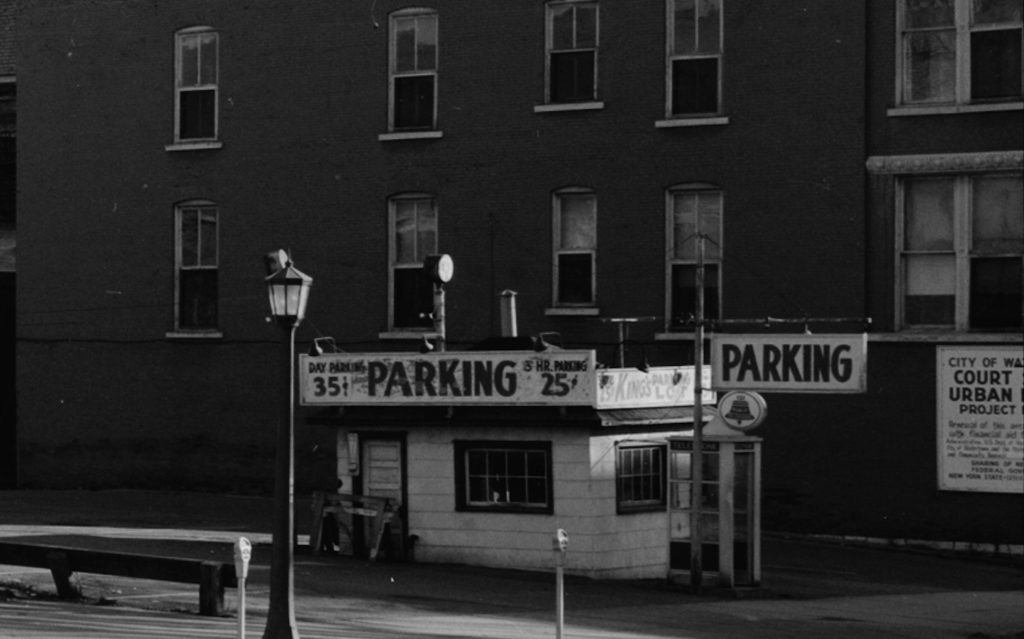
The $16.8 Million Arterial Plan Seeks Revival
Meanwhile, the arterial plan sitting dormant since 1962, had dust shaken off it and updated to include a north-south arterial starting at Bradley Street and ending at the city limits on Washington Street, using parts of various existing streets.
Acquisition costs were estimated at $2,500,000, while the arterial highway plan to alleviate traffic flow through the city carried a whopping $16,800,000 estimate. No doubt, whoever dubbed Watertown as the city of the future must have believed the caves along Black River were filled with gold (or black gold) as the plan also included three new bridges over the river.
